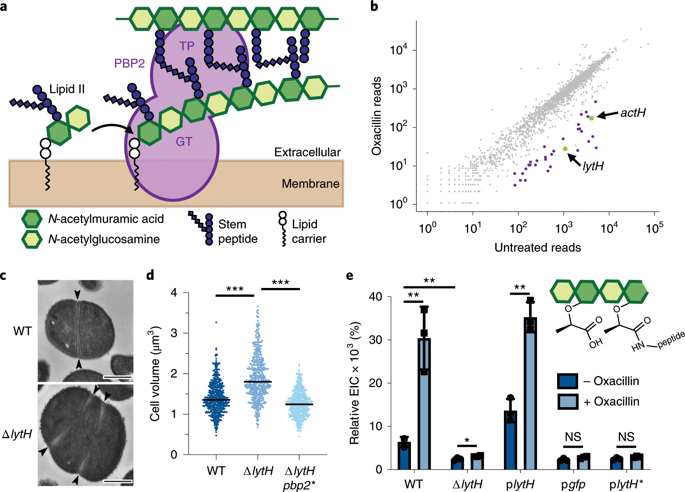Nature Microbiology ( IF 20.5 ) Pub Date : 2020-01-13 , DOI: 10.1038/s41564-019-0632-1 Truc Do 1 , Kaitlin Schaefer 1, 2 , Ace George Santiago 1 , Kathryn A Coe 1 , Pedro B Fernandes 3 , Daniel Kahne 2 , Mariana G Pinho 3 , Suzanne Walker 1

|
Bacteria are protected by a polymer of peptidoglycan that serves as an exoskeleton1. In Staphylococcus aureus, the peptidoglycan assembly enzymes relocate during the cell cycle from the periphery, where they are active during growth, to the division site where they build the partition between daughter cells2,3,4. But how peptidoglycan synthesis is regulated throughout the cell cycle is poorly understood5,6. Here, we used a transposon screen to identify a membrane protein complex that spatially regulates S. aureus peptidoglycan synthesis. This complex consists of an amidase that removes stem peptides from uncrosslinked peptidoglycan and a partner protein that controls its activity. Amidases typically hydrolyse crosslinked peptidoglycan between daughter cells so that they can separate7. However, this amidase controls cell growth. In its absence, peptidoglycan synthesis becomes spatially dysregulated, which causes cells to grow so large that cell division is defective. We show that the cell growth and division defects due to loss of this amidase can be mitigated by attenuating the polymerase activity of the major S. aureus peptidoglycan synthase. Our findings lead to a model wherein the amidase complex regulates the density of peptidoglycan assembly sites to control peptidoglycan synthase activity at a given subcellular location. Removal of stem peptides from peptidoglycan at the cell periphery promotes peptidoglycan synthase relocation to midcell during cell division. This mechanism ensures that cell expansion is properly coordinated with cell division.
中文翻译:

金黄色葡萄球菌细胞的生长和分裂受酰胺酶的调节,该酰胺酶从未交联的肽聚糖中修剪肽
细菌受到肽聚糖聚合物的保护,该聚合物充当外骨骼1。在金黄色葡萄球菌中,肽聚糖组装酶在细胞周期期间从外围(它们在生长期间处于活跃状态)重新定位到它们在子细胞2,3,4之间建立分区的分裂位点。但在整个细胞周期中如何调节肽聚糖合成却知之甚少5,6。在这里,我们使用转座子筛选来鉴定一种在空间上调节金黄色葡萄球菌的膜蛋白复合物肽聚糖合成。该复合物由一种从未交联的肽聚糖中去除茎肽的酰胺酶和一种控制其活性的伴侣蛋白组成。酰胺酶通常水解子细胞之间的交联肽聚糖,以便它们可以分离7。然而,这种酰胺酶控制细胞生长。在它不存在的情况下,肽聚糖合成在空间上变得失调,这导致细胞生长得如此之大,以至于细胞分裂有缺陷。我们表明,可以通过减弱主要金黄色葡萄球菌的聚合酶活性来减轻由于这种酰胺酶的丢失而导致的细胞生长和分裂缺陷。肽聚糖合酶。我们的研究结果导致了一个模型,其中酰胺酶复合物调节肽聚糖组装位点的密度,以控制给定亚细胞位置的肽聚糖合酶活性。从细胞外围的肽聚糖中去除干肽促进了细胞分裂过程中肽聚糖合酶重新定位到中间细胞。这种机制确保细胞扩增与细胞分裂适当协调。











































 京公网安备 11010802027423号
京公网安备 11010802027423号